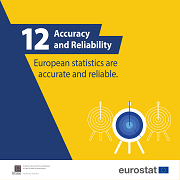Principle 12: Accuracy and Reliability
European Statistics accurately and reliably portray reality.

Indicator 12.1
Source data, integrated data, intermediate results and statistical outputs are regularly assessed and validated.
The statistical products published by INSEE are subject to checks throughout their production chain. The checks carried out at individual level (micro-checks) make it possible to ensure the consistency and validity of the data from a questionnaire or an administrative source. These can be, for example, checks on orders of magnitude, units or changes between two responses or editions.
Checks are also carried out on aggregated data (macro-checks). The consistency of the macro-data is checked internally (additivity checks, value likelihood checks), in terms of time (checks on changes) and by comparison with other sources. These macro-checks are three of the seven criteria (along with expected quality, the existence of documentation, the existence of a specific organisation and the control of disseminated data) used by statisticians to evaluate their systems for checking and validating aggregated data.
These macro-checks result in redirections back to the data on individuals when anomalies are found. This iterative procedure improves the reliability and quality of the results of statistical processes.
For some INSEE processes, such as the determination of legal populations from the census, most of the checks are carried out in the Institute’s regional establishments.
Indicator 12.2
Sampling errors and non-sampling errors are measured and systematically documented according to the European standards.
Sampling errors are related to the fact that the estimates obtained from survey data may deviate slightly from the results that would have been given by exhaustive interviewing. Errors not connected to sampling are related to errors in coverage, measurement, non-response, processing, etc.
The INSEE Department of Statistical Methods supports survey managers or administrative data processing managers. It ensures the internal availability of several methodological resources that make it possible to homogenise practices and optimise the tools and techniques used. They relate, in particular, to the precision and control/adjustment of the samples. Thus, for “household” surveys for example, there is a quality assurance framework that gives the main steps to be followed to measure and document random and non-random errors.
The methods for measuring errors, whether random or not, are part of the basic documentation to be attached to source metadata and made available to users. In accordance with international rules and standards, quality indicators (total and partial non-response rates, accuracy of estimators, etc.) and even end-of-production or collection assessments are distributed with the metadata of the source concerned on the insee.fr website.
In advance of the surveys, the quality of the sampling frames (particularly in terms of coverage and possible duplication) is examined regularly, particularly when work is being carried out to renew them.
Indicator 12.3
Revisions are regularly analysed in order to improve source data, statistical processes and outputs.
The General Revisions Policy of the French Official Statistical Service, which was formalised in 2019, explicitly states that revisions “shall be analysed to ensure and improve the quality of data, methods of production or dissemination, and revision procedures; the findings from these analyses shall be included in quality reports; to conduct these analyses, data both pre- and post-revision must have been archived beforehand”.
Revision analyses are integrated with a source’s metadata, which are made available to users on the insee.fr website.
Thus, the Annual National Accounts include a methodological note presenting the main revisions made to the National Accounts in 2016, 2017 and 2018. It analyses the revisions, presents the technical details and consequences and justifies the choices made with a view to improving the processes and statistics. Finally, text boxes on the impact of revisions are also included in the Informations Rapides (Quick Information) publications.


